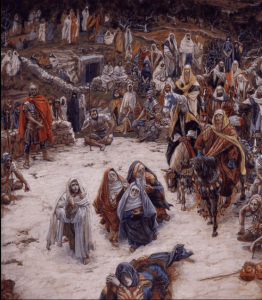Seeing this in a museum what would you think it was?

Seeing it while driving, you would immediately watch for an intersection ahead. If you never saw a car in your life, you would not be even able guess what it was.
Seeing this in a museum what would you think it was?

James Tissot painted the crucifixion from the point of view of Jesus on the cross. Would somebody from a non-Western cultural context even come close in a guess?
Life is culturally conditioned, so is art. Someday neuroscience might tell us what is common to all humans, but that is likely to be tendencies, probabilities, not certainties.
Without context you cannot determine what an image is. If words are needed, what is the difference between a picture and an illustration? An illustration is used to illuminate the words. An illustration is worth a thousand words. But a work of art, a true picture, needs no words, as I argued in my last post, you only need to understand its cultural context.
Life is ambiguous — cultural context allows people to communicate. Is the word ‘bank’, the bank of a river, or a bank where money is stored? Once the ambiguity is clarified, the meaning is clear. Sometimes the agreement itself is vague. The Declaration of Independence talks about “life, liberty, and the pursuit of happiness.” ‘Happiness’ is unambiguous, but vague.
Insisting on one true context, modern artists in the late 19th and early 20th century engaged in intellectual warfare to put forth their view of art as the correct one. They believed in the evolution of intellectual, social, economic, and political values towards perfection. A conceit we now understand to be foolish.
We live in culturally fragmented world, with continents, islands, and isthmuses of cultural context.
How can then one apply a single understanding to Rembrandt and Reinhardt? To Mondrian and Michelangelo? Cindy Sherman and Bosch? Bernini and Giacometti?
To understand each we must attempt the mentally and emotionally difficult task of placing ourselves in a different world. Previously, I discussed some ideas on how to do this.
Recently, I listened again to music that took me 25 years to appreciate — Beethoven’s Grosse Fuge. It took 100 years after its first performance for the musical community to understand it. Stravinsky claimed “The Great Fugue… now seems to me the most perfect miracle in music.. It is also the most absolutely contemporary piece of music I know, and contemporary forever… Hardly birthmarked by its age, the Great Fugue is, in rhythm alone, more subtle than any music of my own century… I love it beyond everything.”
Not that I totally understand it, but the hard work has allowed me to immerse myself in one of the greatest works of art. Modern recording technology, allows us to get much closer to a live performance than a reproduction of a great work of visual art.
Today artists issue statements about their work. Often just polemics, or attempts to get social media attention, mostly they try to clue us into their cultural islands.
With cultural islands, and little present agreement on cultural context, some people even denigrate what was considered great art of the past, failing to understand art whose cultural context they do not share, or even despise.
Battles over public art are really battles of varying cultural contexts waged in the name of truth.
With cultural fragmentation, how do we even know what is art?
Astute and thought provoking as always, Michael–thanks.
Here’s what I want to know: In what cultural context is Jeff Koons an artist? I actually like a lot of his stuff (who couldn’t like Puppy?), but as about the most expensive of living artists, I’d suggest that his cultural context is actually billionaires and their art advisors. Whatever this small group thinks tends to become our broader context, which is just so wrong. In fact, we all have the right to our own aesthetic.
Thanks.
I agree that we all have the right to our own aesthetic.
I have a post planned on kitsch which I hope will shed some light on Koons.
I also plan to do a post on billionaires and their art advisors, although I have a feeling some of that market is driven by money laundering. Of course there is the old stock market joke about trading sardines.